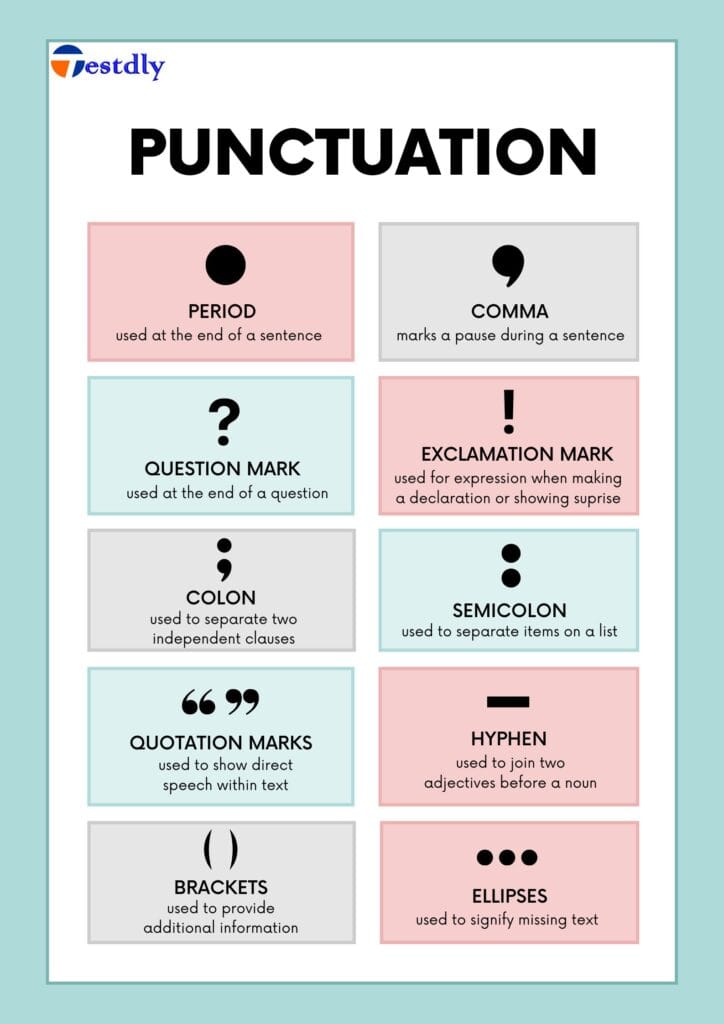Punctuation: Enhancing Clarity and Meaning in Writing
Punctuation plays a vital role in written communication, serving as the backbone of clarity, coherence, and understanding in the English language. By utilizing various punctuation marks effectively, writers can convey their ideas more precisely and help readers navigate through their text with ease. In this post, we will explore the significance of punctuation and delve into the functions of some common punctuation marks.
quiz; Punctuation
Period (.)
The period is a fundamental punctuation mark used to signify the end of a declarative sentence. It provides a full stop, indicating a complete thought or idea. For example: “The sun sets in the evening.”
Comma (,)
The comma is a versatile punctuation mark that serves multiple purposes. It is commonly used to separate items in a list, such as “apples, oranges, and bananas.” Additionally, commas are employed to set off introductory phrases, join independent clauses with coordinating conjunctions, and separate items in dates and addresses.
Question Mark (?)
The question mark is used to indicate a direct question. It is placed at the end of an interrogative sentence, signaling that a response or clarification is sought. For instance: “What is your favorite color?”
Exclamation Mark (!)
The exclamation mark is employed to express strong emotions, excitement, or emphasis. It adds a sense of enthusiasm or urgency to a sentence. For example: “Congratulations on your remarkable achievement!”
Quotation Marks (” “)
Quotation marks are used to enclose direct speech or quotations from other sources. They indicate that the words within them are being attributed to someone else. For instance: She said, “I’ll be there in a minute.”
Semicolon (;)
The semicolon is used to connect two closely related independent clauses that could stand alone as separate sentences but are linked in meaning. It provides a stronger connection than a comma alone. For example: “She finished her work; then she went for a walk.”
Colon (:)
A colon is primarily used to introduce a list, explanation, or example. It signals that what follows is directly related to or expands upon the preceding information. For instance: “Please bring the following items: a pen, paper, and a calculator.”
Apostrophe (‘)
The apostrophe serves two primary purposes: indicating possession and contraction. It is used to show ownership or belonging, as in “John’s car.” Additionally, it is employed to represent the omission of letters in contractions, such as “can’t” (cannot) or “don’t” (do not).
Ellipsis (…)
The ellipsis consists of three consecutive dots and is used to indicate the omission of words or a pause in speech or thought. It creates a sense of suspense or leaves a thought unfinished. For example: “She hesitated and then said… never mind.”
Parentheses ( )
Parentheses are used to enclose additional or explanatory information within a sentence. The content within parentheses provides supplementary details but can be omitted without affecting the overall meaning of the sentence. For instance: “The conference (scheduled for next week) has been postponed.”
Mastering punctuation enhances the clarity and effectiveness of your writing, allowing readers to engage more effortlessly with your ideas. By understanding the functions and proper usage of punctuation marks, you can elevate your written communication to a new level of precision and coherence.
Remember, punctuation is like a roadmap for your words, guiding readers through your thoughts and ensuring your message is conveyed accurately. So, embrace the power of punctuation and unlock the full potential of your writing!














1 thought on “Punctuation: Enhancing Clarity and Meaning in Writing”